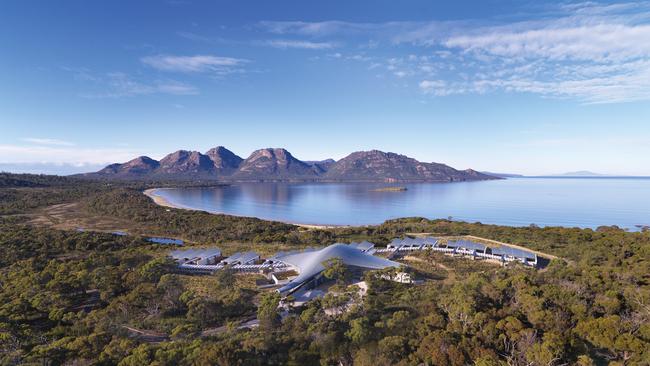Tasmania’s Saffire Freycinet gets guests into the great outdoors
Saffire Freycinet has an array of new nature-based experiences.

Gentlemen of a certain age, Murray the Moocher and Malcolm in the Middle, are enjoying the good life in their 1ha open-range “retirement” enclosure. Ranger Nicole tosses them dinner (a haunch of culled wallaby leg, you two chaps, or a chaser of brushtail possum?) and we watch and listen in astonishment as they crunch the bones with the purposefulness of waste disposal units. Together with two “mature” females, these Tasmanian devils, the world’s largest carnivorous marsupials, have a new home at Saffire Freycinet at Coles Bay on the Apple Isle’s east coast.
In conjunction with Wildcare and the Menzies Institute for Medical Research, Saffire is keen to educate its well-heeled guests about Tasmanian devils and create awareness of, and raise funds to find a vaccine for, the contagious facial tumours threatening the survival of the species. Visiting the creatures at dusk is offered in a portfolio of activities designed to get Saffire guests out and about and reconnected with nature.
The award-winning property opened five years ago and this is my second visit. The lodge has been a resounding success, with about 30 per cent of guests from overseas, loyal repeat clientele and average length of stay a leisurely three nights. The buildings seem more earthed in their surroundings now and the architecture timelessly spectacular. Twenty pavilion suites, each a bower of uncompromised comfort (think two-person showers, deep tubs, lounging spaces with books and chess sets, complimentary minibar and beds with a view), face the pink-tinged Hazards mountain range across Great Oyster Bay. It is a panorama so mesmerising, especially in dawn’s pearled light, as to seem unreal, as if you have woken up to an IMAX screening. These single-storey accommodations (named for local fauna and flora, peaks and pioneers), with roofs that crest like waves, fan out as satellites to the stingray-shaped main building.
The communal Sanctuary lodge — home to reception, Palate restaurant and a convivial lounge — was designed using island timbers, stone and slate by Hobart practice Circa Morris Nunn with a sense of voluminous proportions and abundance of natural light. Staff turn window-side easy chairs around at night to face the eco-fireplace — a lovely little touch and one much appreciated by readers and snoozers.
But enough of idleness. Time to head out with lodge guide Joel and Captain Steve for a bouncy, bracing Schouten Island Experience on a covered cruiser that will see us skirt Great Oyster Bay and pull into secret coves where the foaming water is silvery green and clear as glass; we spot wheeling gulls and oyster catchers, and there is the prospect of albatrosses, the suggestion of seals (“aqua dogs” according to our crew) and we are blessed with sightings aplenty. On such an expedition, and depending on season and fortune, you could encounter common or bottlenose dolphins and even orcas.
We spy white-bellied sea eagles perched on winter-bare branches, shags (cormorants) on rocks, and listen to Captain Steve’s tales of the region’s early, and often lawless, history, of rough whalers and tough miners quarrying seams of pink feldspar, of the likes of an American whaling captain, Richard Hazard, whose oddly suitable name lives on amid the peninsula’s harsh geography.
“It’s about eight degrees down there in winter,” announces Captain Steve as we comment on the inviting colour of the ocean. Summer? “A glorious 21 degrees.” As we nose through slender Schouten Passage, the landscape becomes near-vertical, all high and chiselled cliffs, some with black and orange fluted striations that look freshly daubed with paint. We pass wind-gouged rocks and casuarinas with a foothold in tufts of soil so shallow they seem suspended in the sky. We are told about pelagic sea squirts that glow at night as vivid as Christmas lights. At Trumpeter Bay we see beds of giant string kelp (Macrocystis pyrifera), the fastest growing of its species in the world. Captain Steve leans overboard so far to secure a sample for us that Joel all but grabs his ankles. The brown algae’s texture is airy and it pops under our thumbs like bubble wrap.
The Tasmanian government set up the splendidly titled Scenery Protection Board in 1915 and Freycinet was declared the first national park a year later. Sounds like cause for eternal celebration and out comes morning tea — a spread worthy of a CWA “do”. There are thermoses of tea, plump muffins and crustless sandwiches. We are full from breakfast and don’t partake and then worry that our abstinence will be reported to executive chef (and assistant general manager) Hugh Whitehouse, a generous, ebullient man who, when a spot of afternoon tea was mentioned yesterday, appeared not just with obligatory creamy treats but towers of Pacific oysters. Would we like a spot of champagne vinegar granita to pop on top?
Whitehouse has been with Saffire since its beginning and is ably assisted in the day-to-day delivery of meals by his long-time clever colleague, head chef Simon Pockran. The food is terrific; the produce all carefully sourced, from Flinders Island pasture-fed lamb and fighting fresh seafood such as line-caught pink snapper to Tassie truffles and stone fruit. The inventiveness, complete with edible flowers and the likes of saltbush buds and samphire, comes with an up-to-the-minute urban sensibility that seems astonishing for such a remote locale. The provenance of ingredients is crucial to the language of Whitehouse’s menus, even down to sourdough bread (Hobart’s Pigeon Whole Bakery) and wasabi (Shima in the state’s northwest).
Oysters appear at Saffire in unstinting quantities, direct from the parish’s Freycinet Marine Oyster Farm, where Saffire guests can don clenching rubber waders and learn about wetlands ecology and the growing and harvesting processes. And then, having been shown the tricky technique required to shuck an oyster, partake of dozens and dozens at an anchored table dressed with white linen, perhaps with a flute of fizz to hand.
Then, perchance, back to Spa Saffire for a therapeutic massage using heated stones crafted from the granite of those sentinel Hazards, which makes for a most agreeable mingling of pampering and place.
Checklist
Saffire Freycinet rates include all meals, most beverages, selected activities such as Pelican Bay kayaking and scenic walks plus $100 spa credit. Signature experiences, such as a three-hour Schouten Island cruise ($250), are offered at extra cost. More: 1800 723 347; www.saffire-freycinet.com.au.
Qantas operates four return daily flights between Melbourne and Hobart and one return daily service from Sydney; the two-class (business and economy) services are operated by B717 QantasLink aircraft with Q Streaming on-demand inflight entertainment and iPads in every seat pocket. Qantas is a key sponsors of MONA’s DARK MOFO festival (to Monday) and has added capacity to coincide with the end of the festival. Saffire Freycinet is about two and a half hours by road from Hobart airport via Swansea; transfers can be arranged by chauffeured car, charter plane or helicopter.
More: www.qantas.com.au.
Susan Kurosawa was a guest of Saffire Freycinet and Qantas.



